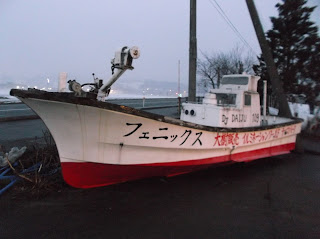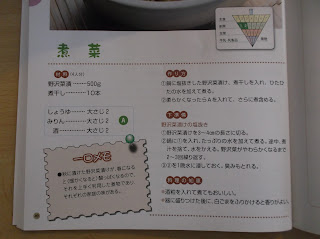Edited to add price information where appropriate.
価格情報を追加しました。
Today, three of us, my wife, daughter, and me, went to the izakaya Houryou, the izakaya that opened last year near my house. The time has come to use the tickets I got at the tasting party.
今日は、私たち三人(妻、娘、私)は居酒屋「豊漁」に行きました。去年、家の近くにできた居酒屋です。試食パーティーでもらった券を使う時が来ました。
Houryou means good catch (of fish). Recently, they placed this boat in their premises. What a surprise!
豊漁とはgood catch (of fish)という意味です。最近、この船が敷地内に設置されました。ビックリしました。
Sorry, too drunk to provide any decent descriptions.
すみませんが、酔っていて、まともな説明ができません。
Edited to add: Now that I am sober, I can provide some descriptions.
追記: もうしらふになったので、ちょっと説明を付けます。
A mug of beer and the otoshi (squid) last night:
ジョッキ一杯のビールと昨日のお通し:
An otoshi is a small appetizer that you are served first when you enter an izakaya.NOTE: An otoshi is not free. You will be charged for it. Roughly, an otoshi is around 300-500 yen.
お通しとは、居酒屋に入って最初に出されるちょっとしたappetizerです。
注: お通しは無料ではありません。料金を請求されます。大まかに言って、お通しの値段は300~500円程度です。
Otoshi: 330 yen
Beer: Complimentary, thanks to the izakaya's flyer that we brought with us, which said you are entitled to a complimentary mug of beer if you bring it with you.
お通し: 330円
ビール: 無料(持っていけばビールが一杯無料でもらえると書いてあった居酒屋のチラシを持って行ったため)
I ordered the shochu and soft drink nomi houdai (drink as much as you can) (90 minutes) plan (1,490 yen).
This plan enables you to select two from among 20 appetizers. As requested by my daughter, I selected french fries (fried potato in Japanese), and
私は焼酎・ソフトドリンク飲み放題(90分)プラン(1,490円)を頼みました。
このプランでは、20種類のおつまみから2種類選べます。娘のリクエストに従って、フライドポテトを選び、
I selected chicken karaage.
鶏の唐揚げを選びました。
A glass of shochu diluted with water.
水で薄めた焼酎:
I had five or so glasses of shochu in total, by diluting with different liquids (green tea, oolong tea, orangeade, and ginger ale).
焼酎は、薄める液を変えながら(緑茶、ウーロン茶、オレンジジュース、ジンジャエール)、全部で5杯くらい飲みました。
My wife ordered a tonkotsu miso ramen.
妻は「とんこつ(豚骨)味噌ラーメン」を頼みました。
790 yen.790円。
My daughter ordered an "ebi-bonara" spaghetti. Ebi means prawn (shrimp, lobster). As you can easily imagine, it's carbonara with prawns in it.
娘は「エビボナーラ」スパゲティーを頼みました。エビとはprawn (shrimp, lobster)の意です。ご想像の通り、エビの入ったカルボナーラです。
890 yen.
890円。
I later ordered a mushroom pizza.
後できのこピザを頼みました。
790 yen.
790円。
"Retro" poster:
レトロなポスター:
Interior of the izakaya:
居酒屋の内部:
These citrus fruits, offered for free, were VERY DELICIOUS!
無料のこの柑橘系の果物がとても美味しかったです。
The owner/chef said they were arita mikan.
オーナーシェフによると、有田みかんだそうです。
We had a good time, but I thought it was not a good idea to take non-drinkers to an izakaya after all.
楽しい時を過ごしましたが、お酒を飲まない人を居酒屋に連れて行くのはよくないなあ、と思いました。
























































